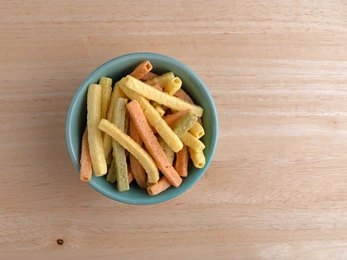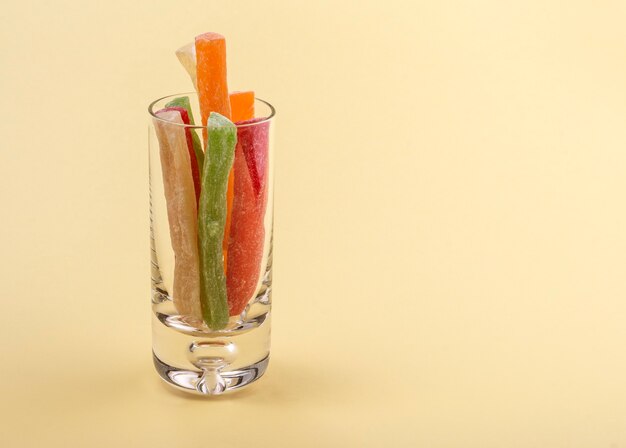Veggie straws have become a popular snack option in recent years. Known for their vibrant colors and crunchy texture, they’re marketed as a healthier alternative to traditional potato chips. With increasing demand for “better-for-you” snacks, veggie straws have secured a significant spot in the U.S. snack market. But are veggie straws truly a healthy choice, or do they just seem like one? Let’s explore their nutritional value, ingredients, and potential health benefits to uncover the truth.
Nutritional Profile of Veggie Straws
Understanding the nutritional content of veggie straws can provide insights into their health impact.
Caloric Content and Serving Size
A standard serving size of veggie straws (approximately 1 ounce or 28 grams) contains about 130 calories. While this is similar to potato chips, the serving size can be deceptive. It’s easy to consume multiple servings in one sitting, leading to higher calorie intake. Moderation is key to preventing overeating.
Macronutrient Breakdown: Carbohydrates, Proteins, and Fats
Veggie straws primarily consist of carbohydrates. A single serving typically contains:
- Carbohydrates: 17 grams
- Proteins: 1 gram
- Fats: 7 grams
Most of the fats are unsaturated, making them relatively healthier. However, the low protein content makes them less satiating compared to high-protein snacks.
Fiber Content Analysis
Despite their vegetable-based name, veggie straws are low in dietary fiber. On average, they provide less than 1 gram of fiber per serving. Whole vegetables, in contrast, offer significantly more fiber, which aids digestion and promotes satiety.
Sodium Levels and Daily Intake Recommendations
One serving of veggie straws contains approximately 220-250 mg of sodium. While this might seem low, it can quickly add up if you consume multiple servings. For comparison, the American Heart Association recommends a daily sodium intake of no more than 2,300 mg. Excess sodium can contribute to high blood pressure and cardiovascular issues.
Ingredients in Veggie Straws
Examining the ingredients in veggie straws reveals more about their nutritional quality.

Primary Ingredients: Potato Starch, Corn Starch, and Vegetable Powders
The main ingredients in veggie straws are processed starches, such as potato starch and corn starch, mixed with vegetable powders. These powders, derived from spinach, tomato, or beetroot, give veggie straws their distinct colors but contribute little nutritional value.
Additives and Preservatives: What Consumers Should Know
Veggie straws often contain additives like salt, sugar, and natural or artificial flavors. Preservatives are used to extend shelf life. While these ingredients are FDA-approved, they may not align with a “whole food” diet, which emphasizes natural and minimally processed foods.
Comparison with Whole Vegetables
Whole vegetables are rich in vitamins, minerals, and fiber. Veggie straws, on the other hand, lose most of these nutrients during processing. For example, eating raw spinach or carrots provides more vitamin A, C, and iron than veggie straws ever could.
Related to Read: Are Frozen Vegetables Healthy? – Everything You Need to Know
Health Benefits of Veggie Straws
Veggie straws do have some positive aspects, but their health benefits depend on how they’re consumed.
Low-Fat Content: A Heart-Healthy Choice?
Veggie straws contain less saturated fat compared to many fried snacks. This makes them a better choice for those monitoring their fat intake. However, they are not completely fat-free and should still be consumed in moderation.
Gluten-Free Options: Catering to Dietary Restrictions
Veggie straws are naturally gluten-free, making them suitable for individuals with celiac disease or gluten intolerance. This broadens their appeal among people with dietary restrictions.
Allergen Information: Safe for Peanut and Tree Nut Allergies?
Veggie straws are typically free of peanuts and tree nuts. This makes them a safe choice for people with these common food allergies. However, always check the packaging for potential cross-contamination warnings.
Table: Nutritional Comparison – Veggie Straws vs. Whole Vegetables
| Nutrient | Veggie Straws (1 oz) | Whole Vegetables (1 cup) |
| Calories | 130 | 25-50 (varies by vegetable) |
| Carbohydrates | 17 g | 5-10 g |
| Protein | 1 g | 2-3 g |
| Fat | 7 g | <1 g |
| Fiber | <1 g | 2-4 g |
| Sodium | 220-250 mg | <50 mg |
This table highlights the nutritional gap between veggie straws and whole vegetables, emphasizing the latter as a healthier choice.
Potential Health Concerns
Veggie straws may seem like a healthier snack, but they come with certain drawbacks that deserve attention.
High Sodium Intake: Risks and Recommendations
Veggie straws contain significant sodium levels, with up to 250 mg per serving. Consuming multiple servings can push your sodium intake beyond daily recommendations. High sodium levels are linked to high blood pressure and cardiovascular issues. For those on low-sodium diets, veggie straws may not be an ideal choice.
Lack of Essential Nutrients Compared to Whole Vegetables
Despite their vegetable-derived ingredients, veggie straws lack the vitamins, minerals, and fiber found in whole vegetables. This nutrient deficit is due to the heavy processing involved, which strips away most natural goodness. Choosing fresh or minimally processed vegetables is always a better option.
Presence of Additives: Are They Safe?
Veggie straws often include preservatives, artificial flavors, and other additives. While these substances are approved for consumption, some individuals may experience sensitivities or long-term health concerns. Reading ingredient labels can help you make more informed choices.
Veggie Straws vs. Traditional Potato Chips
How do veggie straws stack up against traditional potato chips? Let’s break it down.

Nutritional Comparison: Calories, Fats, and Sodium
Both veggie straws and potato chips are processed snacks, but veggie straws are slightly lower in saturated fats. However, their sodium and calorie content are comparable. For example:
- Veggie Straws (1 oz): 130 calories, 7g fat, 250 mg sodium
- Potato Chips (1 oz): 150 calories, 10g fat, 180-200 mg sodium
While veggie straws may appear lighter, they don’t offer a significant health advantage over potato chips.
Taste and Texture: Consumer Preferences
Veggie straws are known for their airy crunch and mild flavor. This appeals to consumers seeking a lighter snack. Potato chips, with their bold flavors and dense texture, tend to satisfy cravings more effectively.
Cost Analysis: Are Veggie Straws Worth the Price?
Veggie straws are often priced higher than traditional chips, mainly due to their marketing as a “healthier” option. Considering their minimal nutritional benefit, the added cost may not be justified for budget-conscious consumers.
Expert Opinions on Veggie Straws
Healthcare professionals and dietitians have mixed views on veggie straws as a snack option.
Dietitian Insights: Are They a Healthy Snack?
Dietitians often caution against assuming that veggie straws are equivalent to vegetables. While they can fit into a balanced diet as an occasional treat, relying on them for nutritional value is not recommended. Opting for snacks with higher protein and fiber content is often advised.
Medical Community Perspectives on Processed Snacks
Medical experts agree that processed snacks like veggie straws are not substitutes for whole, unprocessed foods. They stress the importance of moderation and highlight potential long-term health risks from high sodium and low nutrient content.
Recommendations for Health-Conscious Consumers
For those looking to maintain a healthy lifestyle, experts recommend choosing whole vegetables, nuts, seeds, or homemade snacks. These options provide more nutrients and help curb hunger more effectively.
Related to Read: Is Boiling Vegetables Healthy? Benefits, Drawbacks, and Tips for Nutrient Preservation
Healthier Alternatives to Veggie Straws
There are plenty of alternatives that offer better nutrition and satisfy your snack cravings.
Homemade Vegetable Chips: Recipes and Benefits
Making your own vegetable chips at home is simple and healthier. Thinly slice sweet potatoes, kale, or zucchini, lightly season, and bake until crispy. Homemade chips are free of preservatives and allow you to control the sodium content.
Whole Vegetable Snacks: Carrot Sticks, Celery, and More
Raw vegetables like carrot sticks, celery, cucumber slices, and bell pepper strips are nutrient-dense and low in calories. Pair them with hummus or Greek yogurt dip for added flavor and protein.
Nuts and Seeds: Protein-Packed Options
Almonds, walnuts, sunflower seeds, and pumpkin seeds are excellent snack options. They’re rich in protein, healthy fats, and essential nutrients, making them a satisfying and nourishing alternative.
Conclusion
Veggie straws can be enjoyed as an occasional treat but shouldn’t be mistaken for a healthy snack. Their low fiber and nutrient content, combined with high sodium levels, limit their health benefits. To make informed snack choices, consider incorporating whole, minimally processed foods into your diet. Remember, balance and moderation are key to a healthier lifestyle.
Frequently Asked Questions (FAQs)
1. Are Veggie Straws Suitable for Weight Loss Diets?
Veggie straws can fit into a weight-loss plan when consumed in moderation. However, their low fiber and protein content make them less filling than other snacks, potentially leading to overeating.
2. Do Veggie Straws Count as a Serving of Vegetables?
No, veggie straws do not count as a serving of vegetables. They lack the vitamins, minerals, and fiber found in fresh vegetables.
3. Can Children Safely Consume Veggie Straws?
Yes, veggie straws are generally safe for children. However, they should be given as a treat rather than a regular snack due to their low nutritional value.
4. Are Veggie Straws Vegan-Friendly?
Most veggie straws are vegan-friendly, but it’s essential to check the packaging for any animal-derived ingredients or flavorings.
5. How Do Veggie Straws Affect Blood Pressure?
Veggie straws contain high sodium levels, which can contribute to elevated blood pressure if consumed in large quantities. Opt for low-sodium snacks if this is a concern.

